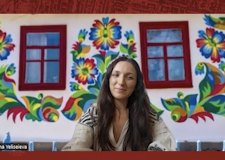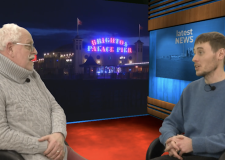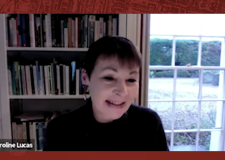Brighton fashion designer’s journey from Palestine to the Pavilion
By Rosy Matheson
A new exhibition in Brighton shows how a dynamic immigrant overcame childhood adversity to create a legendary fashion brand.
Barbara Hulanicki, who founded Biba, moved to Brighton when she was 12 after her father was assassinated in Palestine.
Witold Hulanicki, a Polish diplomat, was working as a mediator between Arab and Jewish organisations when he was murdered by the Stern Gang in 1948 just months before the state of Israel was created.
The family fled to England, seeking refuge with an aunt in Sussex.
From this inauspicious start, his daughter, Barbara, went on to create a fashion empire that dominated the 1960s and 70s, transforming the high street shopping experience with her chic yet affordable outfits.
Twiggy said that Barbara Hulanicki “changed fashion in England single-handedly”.
In Biba and Beyond, at Brighton Museum and Art Gallery, in the grounds of the Pavilion, Barbara Hulanicki’s early life is documented as well as her glittering career in fashion and interior design.
Excerpts from her autobiography from A to Biba line the walls of the exhibition which runs until April.
On display are a series of black and white photos of her family. Beside an image of her dad, there is an inscription from Barbara, describing when he left home for the last time: “I didn’t jump out of bed and kiss and hug him. I just let him go.
“It has always haunted me that I didn’t reach out to touch him for the last time.”
This final farewell has understandably left an indelible mark on Barbara who’s now in her seventies.
She still can’t talk about this traumatic event, saying: “It is just too painful.”
However, she’s eager to talk about the rest of her childhood and what it was like to grow up in Sussex.
When her family arrived in Brighton they moved in with her strict but stylish aunt. Though Barbara and her aunty didn’t have an easy relationship, this stern woman was to become the ultimate influence in the Biba look.
And looking round the exhibition, her aunt’s fashion sense is apparent in many of the costumes on show.
They reflect the elegance of another era, especially the 1930s style bias-cut dresses in satin, the Edwardian-type dresses with their high collars and the “pyjama” trouser suits which looked like they had come straight from the 1920s.
Barbara remembers it was difficult when they first arrived: “We were an oddity and seen as foreigners in a sleepy seaside town.”
However, she says this only increased her drive as “being a foreigner at the beginning certainly made me very determined”.
She was sent to boarding school in Worthing and then went on to Brighton Art College.
In her spare time, she would often go to her local “flea pit” to see Hollywood films and idolised Audrey Hepburn with her big eyes, long neck and willowy frame. She was the prototype for the “Biba dolly” look that Barbara so loved.
After art school, she started work as an illustrator and married Stephen Fitz-Simon in 1961. Together they set up a mail order business called Biba’s Postal Boutique.
A turning point came in 1964 when Barbara was asked to design a dress for the Daily Mirror. She came up with a Brigitte Bardot inspired pink gingham dress and matching head square. It was so popular that 17,000 outfits were sold.
The first Biba Boutique opened in London later that year. It was “the” place to be seen. Mia Farrow, Mick Jagger, Yoko Ono and Cher were just some of the celebrities who shopped there.
Demand
A year later Biba opened in Brighton and fans rushed to the Queen’s Road store. Their memories were recorded as part of the Biba and Beyond exhibition.
One such fan was Hilary Masters. Apparently there was such demand for these garments that the “superbly” dressed assistants didn’t need to try too hard: “It was dark, it was intense and you couldn’t stay in there very long because that would have been uncool, so you had to make lots of frequent trips. The shop assistants didn’t want to serve you.”
Another Biba aficionado was Rosemary Hector. She liked the clothes because older people didn’t: “It was everything our mothers despised, it was casual and uncorseted … it was a come as-you-please fancy dress ball of a place.”
The breadth and range of costumes on display are a testament to this, from the blue polka dot skirt suit, to the stylised flower print jump suit (with matching floppy hat) to the full-length faux leopard skin hooded coat and see-through lace dresses – all designed for skinny girls with long, “asparagus legs”.
According to an excerpt from the autobiography, the first mini-skirts that Biba sold were very short because the stretch jersey fabric had shrunk accidentally.
Barbara recalls that she was shocked by the length of the material: “I nearly had a heart attack. The skirts were only 10 inches long.
“‘God,’ I thought, ‘we’ll go bust. We’ll never be able to sell them.’ I couldn’t sleep, but that little fluted skirt walked out on customers as fast as we could get it on to the stands.”
Despite the success of the Brighton shop it had to close. A notice on the wall explains why: “We employed a manageress who lived above the shop, but we hadn’t realised that she was a mobsters’ moll who entertained half the Brighton underworld!
Protection money
“Stock was disappearing by the armful, and when a very famous ex-boxer came to see the ‘governor’ in Church Street [London] to demand protection money. We felt we should call it a day.”
In 1974 Barbara called time on the Biba chain itself and opened a number of other boutiques, as well as launching a make-up range.
In 1987 she moved to Miami and began a successful career in interior design and architecture.
She designed bars, offices and recording studios for the likes of Ronnie Wood from the Rolling Stones, pop star Gloria Estefan and Chris Blackwell from Island Records.
In fact Barbara is credited with re-conceiving Miami Beach’s Art Deco district.
She says that many of her interior design ideas and collections were actually inspired by visiting the antiques shops in Brighton’s lanes in her youth.
At a time when most people would be looking forward to a quiet retirement, Barbara is busier than ever. She’s now designing contemporary clothing collections for Topshop and George at Asda which have been very well received.
Cool modern celebrities like Alexa Chung, Kate Moss and Fearne Cotton have been seen modelling her ranges.
Currently she spends most of her time between Miami and London and is pleased that things have changed so much in Britain. The shops in particular are much better: “There was nothing nice to buy in the 60s.
“It’s difficult to imagine today as there is too much to choose from.”
She said she was really impressed by Brighton when she visited it recently: “I hadn’t been to Brighton in almost 20 years. I was so surprised. It’s a fun and very energetic place now.”
Barbara hasn’t ruled out a return to the city as it has “beautiful architecture and is close to London”. If she does come back here, Brighton’s going to need every ounce of that energy to keep up with this dynamic, globe-trotting septuagenarian.
Fact file
1936 Barbara Hulanicki born in Warsaw, Poland
1948 Moved to Brighton from Palestine
1955 Won an Evening Standard competition for beachwear
1964 Opened the first Biba shop
1980 Opened a number of boutiques under her own name
1983 Wrote her autobiography from A to Biba
1987 Moved to Miami
2011 Awarded outstanding contribution to fashion at the Global Fashion Awards in New York
2012 Awarded an OBE for her contribution to British fashion






















